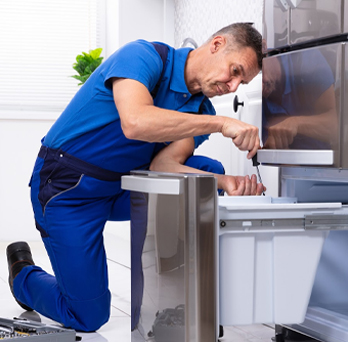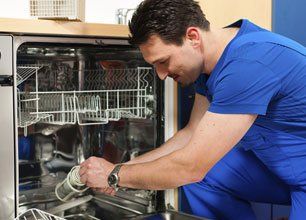The Ultimate Guide to Do It Yourself Appliance Fixing Methods
From fridges to dishwashing machines, understanding just how to troubleshoot and repair these devices can save you time and money. Are you ready to discover important methods that will equip you to manage repair services with confidence?
Recognizing Usual Device Troubles
When you count on your home devices, it can be discouraging when they instantly quit functioning or break down. Comprehending typical home appliance problems can help you troubleshoot concerns properly. If your fridge isn't cooling, check the temperature level setups or check the door seal for spaces. A malfunctioning cleaning equipment may be because of a blocked drain filter or a busted belt.
If your oven isn't heating, damaged aspects or thermostat issues might be at fault. Dish washers commonly experience problems with water drainage, so make sure the filter is tidy and the drain hose isn't kinked.
Likewise, listen for uncommon sounds; they commonly indicate mechanical concerns. By recognizing these indicators, you can save time and possibly avoid expensive repairs. A little knowledge goes a lengthy method in keeping your home appliances, so remain informed to maintain everything running smoothly.
Crucial Tools for Do It Yourself Services
Prior to diving into do it yourself device repair work, it is necessary to gather the right tools to assure the procedure goes smoothly. Begin with an excellent set of screwdrivers, including both flathead and Phillips, as they're crucial for opening most appliances. You'll likewise desire a set of pliers for gripping and twisting cables or tiny components.
Don't fail to remember a multimeter; it assists you examination electrical elements and detect issues efficiently. An outlet collection comes in handy for loosening up or tightening bolts, while an utility blade can be valuable for opening up or reducing wires packaging.
Lastly, take into consideration having a flashlight accessible to illuminate dark spaces inside your home appliances. With these crucial devices, you'll be well-appointed to tackle various repair work, saving both time and cash. Collect your equipment and obtain all set to roll up your sleeves!
Safety First: Precautions to Take
Before you start any kind of device repair, it's important to focus on security. Ensure you wear individual safety devices, detach the source of power, and keep your workspace arranged. These easy preventative measures can aid protect against crashes and ensure a smoother repair service procedure.

Personal Safety Equipment
Safety and security gear is an important part of any kind of do it yourself home appliance repair service job. You need to always use safety goggles to protect your eyes from dirt and debris. A tough pair of handwear covers will secure your hands from dangerous products and sharp sides. Take into consideration using a mask if you're dealing with chemicals or dirt, ensuring you breathe safely while working. Steel-toed boots are additionally a wise selection, particularly when lifting heavy home appliances. Don't forget to put on long sleeves and trousers to safeguard your skin from potential injuries. By focusing on personal protective devices, you'll greatly decrease the risk of injuries and mishaps. Bear in mind, being prepared with the ideal equipment keeps you secure and focused on finishing your repair service effectively.
Power Source Interference
To guarantee a risk-free DIY device fixing, disconnecting the source of power is crucial. Before you start any kind of work, you need to disconnect the home appliance or turn off the breaker. This basic action prevents electrical shocks and warranties that you can focus on the repair work without fretting about unintentional activation. Constantly verify that the home appliance is off by checking it with a voltage tester. If you're taking care of bigger home appliances, like a washer or dryer, see to it to protect the power cable and prevent any type of contact with water. Keep in mind, safety and security initially! As soon as you're positive that the power is disconnected, you can with confidence continue with your fixings, recognizing you've taken the required precautions to shield on your own.
Work Location Organization
A well-organized work area can make all the difference in your Do it yourself device fixing task. Start by removing your office of mess to protect against distractions and mishaps. A neat room not just improves effectiveness however likewise keeps you safe while you work on your appliance repair.
Step-by-Step Overview for Refrigerator Fixes
When your fridge begins acting up, it can be frustrating, yet taking on the problem on your own can save you time and money. Examine for typical problems like temperature fluctuations or unusual noises. For a loud fridge, inspect the fan and verify it's not obstructed.
If there's water pooling inside, evaluate the door seals for damages or dirt, and clean them if needed. When you've addressed the issue, plug the refrigerator back in and monitor it for a few hours.
Dealing With Washing Device Problems
Simply like refrigerators, cleaning machines can present their very own collection of difficulties, yet many issues can be solved with a bit of troubleshooting. Read More Here If your equipment won't begin, examine the power cord and validate it's plugged in.
Tightening these can usually solve the problem. Routine maintenance, like cleaning up the filter, can avoid lots of problems from emerging.
Fixing Ovens and Stoves
Exactly how can you repair typical problems with your stove or range? Start by checking the power supply.
If your stove isn't heating, examine the temperature setups and validate the door seals firmly. A defective heating aspect could additionally be the wrongdoer; you could require to change it if it's harmed.
For uneven food preparation, rotate your frying pans and think about utilizing a stove thermostat to confirm precise temperature levels. Lastly, if you listen to unusual noises or scent gas, shut off the device quickly and consult a professional. By adhering to these actions, you web link can identify and settle many typical oven and range issues effectively.
Fixing Dishwashers Made Easy
When your dish washer starts breaking down, it can be discouraging, but addressing common concerns isn't as hard as it seems. You'll find out step-by-step troubleshooting techniques that will help you determine the problem, along with the essential devices you'll require to deal with fixings yourself. Let's make fixing your dishwasher a wind!
Usual Dishwasher Concerns
While dish washers are created to make your life less complicated, they can in some cases run right into common concerns that leave you feeling frustrated. One frequent issue is inadequate cleansing efficiency; this commonly occurs because of clogged spray arms or filthy filters. You may additionally discover water merging near the bottom, which can indicate a malfunctioning drain or a kinked hose pipe. If your dishwasher's door won't latch, it can be an easy issue with the lock mechanism or door seal. Furthermore, odd noises can indicate damaged components or loose components. Ultimately, if you smell something odd, it may be time to check for food debris or a malfunctioning motor. Resolving these concerns early can save you time and problem in the future (Dependable Appliance For SubZero Freezer Repair).

Detailed Troubleshooting
Before diving into repair services, it's crucial to identify the particular issue your dishwasher is dealing with. Begin by checking if it's not cleaning correctly. Check the spray arms for clogs and warranty they rotate openly. Analyze door seals and tubes for any kind of damage if it's leaking. For odd noises, pay attention closely throughout cycles; foreign things may be stuck in the filter or impeller. Inspect the power supply and door latch if your dish washer won't begin. Do not forget to consult your individual guidebook for fixing tips particular to your model. By systematically resolving each possible issue, you can determine the problem and take the required steps to fix it, making your dishwasher function fresh once again.
Essential Fixing Tools
Having the right devices at your disposal can make all the difference when fixing your dishwasher. Begin with a screwdriver set, as browse around these guys you'll commonly need both Phillips and flathead choices. A multimeter's necessary for identifying electric concerns, while pliers can assist you grasp and manipulate various components. Do not fail to remember a bucket or towels for any kind of water spills throughout repair work.
If you're dealing with blockages, a drain snake or a wet/dry vacuum will certainly be very useful. You could likewise want a level to guarantee your dishwashing machine's effectively lined up. Lastly, safety and security equipment like gloves and goggles will certainly protect you while you function. With these crucial devices, you'll be well-appointed to tackle any type of dish washer repair service challenge that comes your means.
Regularly Asked Inquiries
Just how Do I Establish if an Appliance Is Well Worth Repairing?
To identify if a device's worth repairing, consider its age, fixing prices, and existing worth. You might desire to invest in a new design instead - Best Sub-Zero repair Service Dependable Refrigeration & Appliance Repair Service. if repair services exceed half the replacement expense.
Can I Find Substitute Parts In Your Area for My Home Appliance?
Yes, you can typically find substitute components locally for your device. Examine hardware shops, device repair stores, or regional classifieds. Don't forget to bring the version number to ensure you get the appropriate part!
What Usual Mistakes Should I Avoid When Repairing Home Appliances?
When repairing appliances, stay clear of hurrying through diagnostics, disregarding safety and security preventative measures, or making use of wrong tools. Do not skip checking out manuals or watching tutorials; they offer crucial guidance. Be person and comprehensive to assure effective fixings and prevent further damages.
How much time Does a Typical DIY Home Appliance Repair Work Take?
A normal DIY appliance repair work generally takes one to three hours, depending upon the intricacy. You'll desire to gather your tools and materials first, and follow directions meticulously to avoid unnecessary delays.
Exist Any Type Of Guarantees for Do It Yourself Appliance Fixes?
When you tackle DIY home appliance repair work, guarantees normally do not cover your work. Some manufacturers might recognize service warranties for parts you change. Always inspect your appliance's warranty terms prior to starting any fixings to prevent issues.
Prior to diving right into Do it yourself device repair work, it's crucial to collect the right tools to ensure the procedure goes efficiently.Prior to you begin any home appliance repair work, it's essential to prioritize safety.To ensure a secure Do it yourself device repair service, disconnecting the power source is necessary.An efficient work area can make all the difference in your DIY device repair service project. Constantly examine your appliance's warranty terms before beginning any repairs to stay clear of concerns.